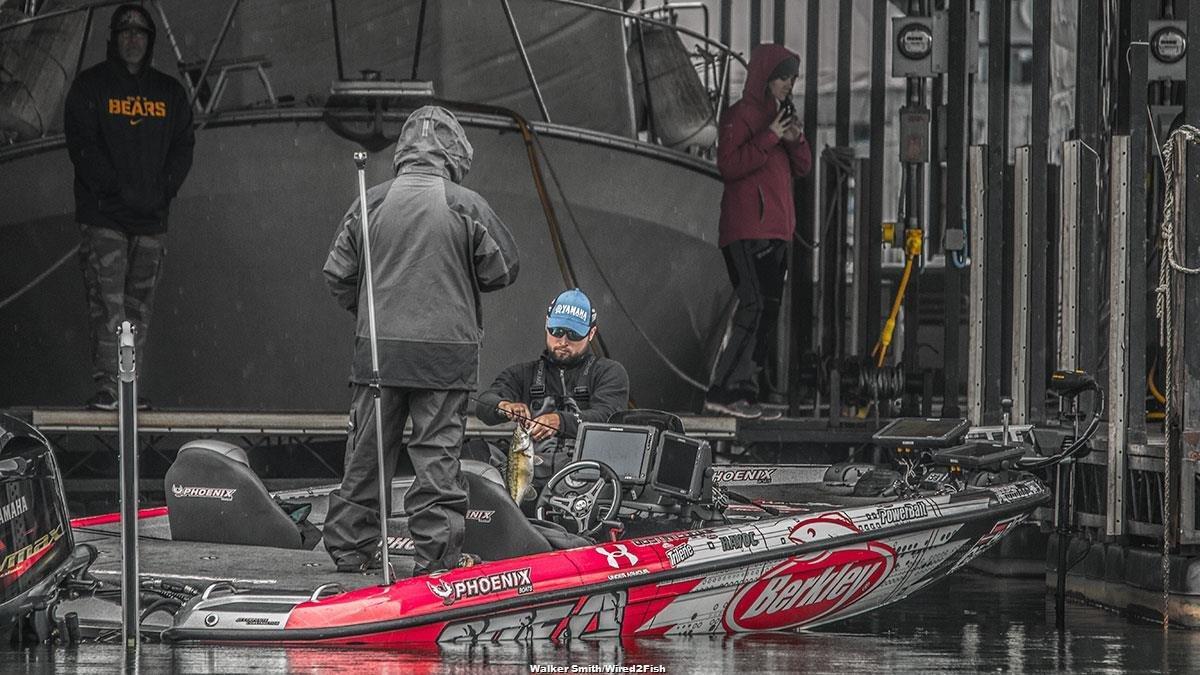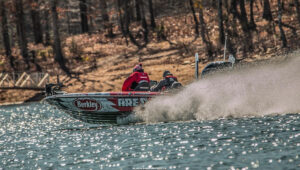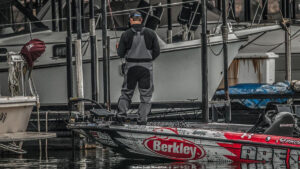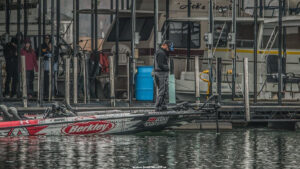If you’re of the belief that all docks are created equal, you may be robbing yourself of countless bass fishing opportunities throughout the year.
Floating docks, in this case, pose several specific and unique challenges to anglers. Many fishermen are more comfortable flipping, pitching or skipping bottom-contact baits to traditional wooden docks—and to be quite honest, it’s hard to blame them. These docks are often adorned with easily detectable bass-holding features such as ladders, cross beams and long, expansive walkways. In other words, they could easily be considered the “low-hanging fruit” of many fisheries.
That’s exactly why, according to Elite Series pro Justin Lucas, floating docks are largely overlooked throughout the country. Don’t let their unostentatious looks fool you, however—they can play host to enormous populations of quality bass.
Lucas believes there are 6 important guidelines that will help you maximize your efficiency and productivity when fishing these often-ignored hotspots.
- The 80% theory
- Focus on isolated docks
- Don’t ignore the bank
- Rule-of-thumb for suspension
- Turn followers into biters
- Three productive lures
The 80% theory
“Thorough” and “successful” are often considered synonomous in regards to bass fishing. If you’re not getting bites, you should slow down and meticulously dissect the areas, right? This is certainly true in some situations, but it couldn’t be further from the truth when fishing floating docks.
“I’ve spent many years experimenting with floating docks and I’ll be totally honest,” Lucas said. “I’ve gotten to the point where I only make one or two casts to a single dock before moving on. 8 out of every 10 bites you get will come in the deepest, darkest pocket of shade and more often than not, they’ll occur on the first few casts. It’s not uncommon for me to fish a floating dock without even deploying my trolling motor.”
Although this seemingly hasty approach may seem a bit overkill to some, it’s important to consider the type of shade floating docks create. The concentration of this shade makes all of the difference.
“Each post of a wooden dock is going to put off a small amount of shade,” Lucas said. “So naturally, the bass have more options in regards to their positioning which makes it necessary to make repeated casts. Floating docks are different. All of the shade is concentrated into a very small area, so there’s not much guesswork involved. You know where a bass is going to be on a floating dock. They’re very predictable.”
Isolated docks can be big bass magnets
Would you rather wrestle a hamburger away from 15 of your neighbors or have it hand-delivered to your doorstep and enjoy it in peace? The answer is simple and, coincidentally, big bass are the same way. They don’t like competition and would rather not fight, scratch and claw when it’s time to fill their bellies.
That’s why isolated floating docks are known to host big bass.
- Reduced competition— “It seems as if the biggest bass prefer to ‘own’ a piece of cover,” Lucas said. “They’re not too keen on having neighbors. So when I’m looking for a big bite, I tend to have a lot of success fishing isolated floating docks. You can certainly catch bass on large stretches of docks, but the most consistent big fish pattern seems to come from small, seemingly ordinary floating docks that sit all by themselves.”
- Concentration points— In areas void of cover, it doesn’t take much to concentrate large quantities of bass, which is another big reason Lucas makes an effort to fish isolated docks. They may not look like much, but that small amount of shade can act as a magnet to big fish and, in his opinion, makes them very easy to target and pattern throughout a fishery.
An added bonus to an already-attractive bank
It’s always nice to find a good-looking dock that’s loaded with enticing features. It’s even better to find a quality stretch of bank that has all of the ingredients necessary for a big bass. But according to Lucas, combining the two is an ideal scenario.
“Floating docks can throw you off if you’re not careful,” Lucas said. “Don’t get tunnel vision on the dock-aspect of this strategy. You also need to pay attention to the bank layout and relative location at all times. I view docks as a welcomed bonus to an already-productive bank.”
As you might have guessed, the “perfect” bank changes with the seasons.
- Winter— Look for floating docks situated on banks with some sort of verticality. Whether it’s a bluff wall or a hard river or creek channel bend, bass are known to inhabit this type of structure in the colder months. They can hang out in the deeper water when they’re inactive and when it’s time to feed, they can easily slide up in the water column for a quick and easy meal.
- Spring— Prior to the spawning period, prespawn females will often stage on floating docks adjacent to spawning flats with a sandy bottom composition. Floating docks on or near secondary points or any type of irregularity can be an excellent choice throughout the entire spring. Not only do the prespawners use these docks, but you’ll also be able to find post-spawn bass underneath them as well.
- Summer— Verticality returns as an important theme in the summer months. Sharp depth changes will attract bass, making primary points quite productive. Bass can feed on top of the points or slide off into deeper water when they’re inactive, which allows them to eat as much as possible while exerting very little energy.
- Fall— As the shad start to make their annual migration to the backs of creeks, bass often use floating docks as strategic ambush points. Find these docks on shallow flats near the backs creeks and you’ll most likely find the bass, too.
Are they suspended or on the bottom?
Deciphering whether bass are suspended underneath floating docks or relating closely to the bottom is an enormous key to optimizing your success. Instead of going through an extensive process of elimination, Lucas relies on a general rule-of-thumb he has developed throughout his career.
“When the water temperature is at its coldest point, you’ll find the large majority of the bass sitting tightly on the bottom,” Lucas said. “This is when proper bottom composition such as rocks, boulders or pea gravel plays a big role. I caught almost all of my fish at the 2015 Bassmaster Classic under one floating dock—it had a rock-covered drop I found on my Lowrance Side Imaging that went from 18 to 33 feet. There would have been fish down there without the dock, but the added shade made it even better.”
As the water temperatures begin to warm throughout the spring, summer and fall, however, Lucas has noticed that the bass tend to suspend underneath floating docks.
“During these times of the year, bass are using these docks for both shade and feeding opportunities,” Lucas said. “The docks’ relative locations remain important, but the surrounding bottom composition doesn’t seem to matter as much. Later in the year you’ll begin seeing all sorts of bluegill and shad underneath the floats, so there’s not much of a reason for those bass to sit on the bottom. They’re not going to leave a five-star buffet.”
Turn “followers” into “biters”
Because most floating docks are found on clear, highland reservoirs, non-committal bass are a common problem for fishermen. You might see several 5-pound bass follow your baits over the course of a day without catching a single one.
So how in the world do you avoid this heartbreaking behavior? There are two essential factors, according to Lucas.
- Long casts— “It’s important to become proficient and accurate when making long casts,” Lucas said. “When you’re fishing a reaction lure, your bites will most often occur at least halfway-back to your boat. They don’t seem to commit very well until the lure reaches the end of the dock and seems to be escaping. So if you’re just 10 feet from the dock, the bass doesn’t have much time to commit. Put as much room as possible between your boat and the dock while still being able to make a pinpoint presentation. It helps to use similar rod lengths for consistency, so I actually use all 7-foot Abu Garcia Veracity Casting Rods.”
- Breeze— Flat-calm conditions are challenging when you’re targeting floating docks. The lack of surface disturbance allows the bass to see any unnatural lure characteristics, which drastically decreases the chances of them committing. Lucas believes a slight breeze to be ideal, as he reports catching 95% of “followers” in a slight chop compared to just 50% on a calm day.
Productive presentations to try
As with any technique, you can locate the best floating dock on the entire lake and not get a single bite if you’re not using high-percentage presentations. Although his selection system is simple, bait and lure choice is a key ingredient to Lucas’ approach.
- Shaky head— “When they’re right on the bottom in deeper water, I’ll use a 3/8-ounce shaky head with a Berkley Havoc Bottom Hopper to ensure that my bait stays in the strike zone for as long as possible,” Lucas said. “When they suspend starting in the spring, I’ll downsize to a 1/8-ounce shaky head and they’ll actually follow the bait down and eat it as it falls.”
- Jerkbait— In the winter and early spring months, Lucas relies heavily on a 3 to 5-foot suspending jerkbait. As he works the jerkbait parallel to the floats, the erratic cadence attracts the fish from the dark shadows and entices a lot of strikes.
- Swimbait— “I absolutely love fishing a 4-inch Berkley Powerbait Hollow Belly Swimbait on a 1/4 or 3/8-ounce jighead,” Lucas said. “The cool thing about it is you can be 10 or 12 feet from ‘em and they’ll absolutely bull rush it and smoke it. Not to mention, when the sun is at its highest point and the darkest shade is under the dock, you can skip this swimbait very easily.”
Don’t let floating docks intimidate you this year. It may take a few fishing trips to become comfortable with this technique, but if you make an effort to follow Lucas’ guidelines, you’ll have some outstanding days on the water.















